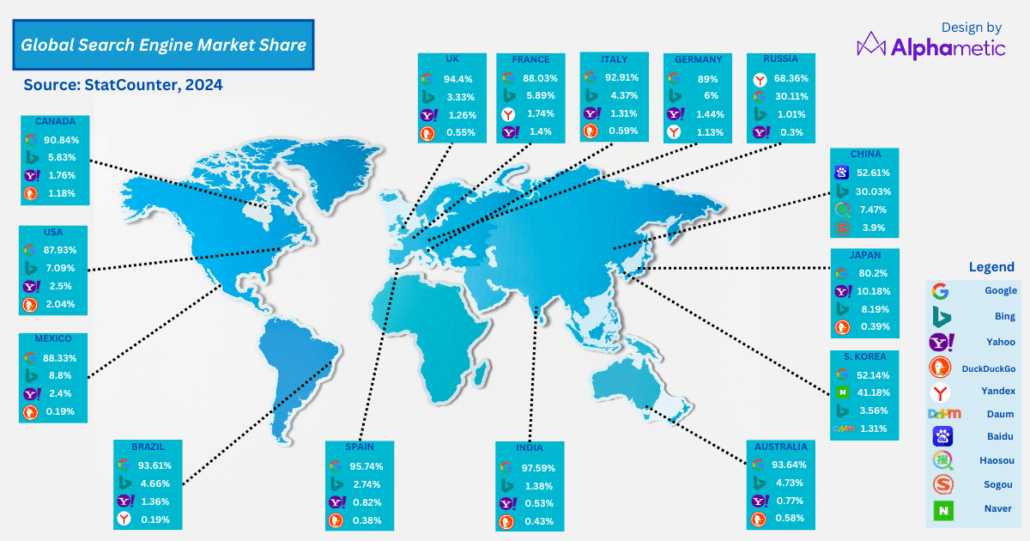Expanding your reach online isn’t just about targeting new countries—it’s about connecting with people in their own language. That’s where multilingual SEO comes in.
In this guide, you’ll learn what multilingual SEO is, why it matters for international success, and how to implement it with 9 essential best practices.
What is multilingual SEO?
Multilingual SEO is the practice of optimizing your website for multiple languages to increase visibility in search engines across different markets.
For example, when a US-based company creates Spanish versions of its English pages to reach Spanish-speaking audiences both domestically and internationally, it is implementing multilingual SEO.
This approach differs from simply translating content—it involves optimizing each language version specifically for search engines using language-appropriate keywords and technical elements.
When implementing multilingual SEO, your existing high-performing content can be adapted to serve other markets, multiplying your organic traffic potential.
Why multilingual SEO matters for global businesses
Multilingual SEO helps you connect with customers in a way that feels natural and familiar. It builds trust by showing your audience that you understand their language and culture.
Visitors are more likely to stay on your site, explore your content, and make a purchase when everything feels easy to understand.
It also helps search engines show the correct version of your site to the right people, making it easier to grow your audience in new markets.
In short, it helps to provide a better user experience, stronger engagement, and a higher chance of turning visitors into customers.
How to implement multilingual SEO: A step-by-step guide
Successful multilingual SEO requires careful planning and methodical execution. Let’s see each step on how to do multilingual SEO correctly:
Step 1: Research and select your target languages
The first step is determining which languages or regions will deliver the best return on your investment. Rather than guessing, use data to make a decision:
- Analyze your current website analytics to identify existing international traffic. Look for patterns of visitors from non-English speaking countries or browser language settings that suggest interest from specific language groups.
- Examine your competitors’ language offerings. If multiple competitors in your industry offer German versions of their sites, this suggests viable market demand for your products or services among German speakers.
- Conduct market research to validate product-market fit. Assess whether your product or service meets a genuine need in the target market and if local alternatives already exist.
Also, you’ll need to evaluate if you have the necessary resources—financial, operational, and cultural expertise—to support expansion into those markets properly.
Step 2: Conduct language-specific keyword research
Multilingual SEO requires thorough multilingual keyword research in each target language—a process that goes far beyond simple translation. Search behavior varies significantly between cultures and languages, even for concepts that seem identical.
The most common mistake businesses make is assuming that translating their English keywords directly will capture the right search intent in other languages.
To develop a strong multilingual keyword list:
- Partner with a native SEO who understands your industry. Their knowledge of language usage will identify natural-sounding terms that automated tools might miss.
- Use keyword research tools with your target language and location settings. Examine both search volume and competition metrics to identify the most valuable opportunities.
- Look at successful competitors in your target language. Check which keywords they rank for and how they use these terms in their website titles, headings, and content. This can reveal valuable keyword opportunities you might otherwise miss.
- Pay special attention to the differences in search intent. A term that indicates purchase intent in one language might be purely informational in another.
Step 3: Choose the right URL structure
Your URL structure is like the blueprint for your multilingual website. How you organize your URLs affects both how search engines understand your site and how visitors navigate between different languages.
Each approach comes with its benefits and challenges:
Country-code top-level domains (ccTLDs)
Domain structure: example.fr, example.de, example.jp
This approach uses separate domains for each country. Big global companies often choose this method because it clearly shows users which country the site is for.
However, it means you need to build SEO for each domain separately, starting from scratch with multiple websites instead of using the domain authority your main site already has.
Pros:
- Clearly shows users and search engines which country you’re targeting
- Can use local hosting for faster loading in each country
- Complete separation between country versions
Cons:
- Have to build authority for each domain separately
- More expensive to maintain multiple domains
- Requires more technical resources and management
Subdirectories
Domain structure: example.com/fr/, example.com/de/, example.com/jp/
This keeps all language versions under your main domain. Search engines see these as parts of the same site, which means your whole website benefits from the authority you’ve already built.
For most businesses, this is the most efficient approach with the easiest setup and best SEO results.
Pros:
- Keeps all your SEO work under one domain
- Easier and cheaper to set up and manage
- Simpler to link between different language versions
- Less expensive (only one domain to register)
Cons:
- Can’t use country-specific hosting for better speed
- May be harder for users to recognize the country targeting immediately
Subdomains
Domain structure: fr.example.com, de.example.com, jp.example.com
While this appears to keep everything under one main domain, search engines typically treat subdomains as separate websites. This means you’ll probably need to build authority for each subdomain individually, similar to having separate domains but with slightly easier management.
Pros:
- Can use local hosting for each language version
- Provides clear separation between language versions
- Easier to manage than completely separate domains
Cons:
- Search engines often treat each subdomain as a separate website
- Need to build SEO authority for each subdomain independently
- More complex to set up than subfolders
Step 4: Prioritize content for translation
Trying to translate your entire website at once can be overwhelming and inefficient. Instead, take a strategic approach by focusing on your most important content first. This lets you test how new markets respond before investing a lot of time and resources.
Organize your content into these priority categories:
- Essential navigation elements should be translated first: headers, footers, menus, and main call-to-action buttons. These elements help users navigate your site in their language.
- Top organic traffic pages are your most valuable SEO assets. Identify which pages already rank well for important keywords in your main language and prioritize translating these to build on existing success.
- Conversion-focused pages directly drive revenue. Translate product pages, service descriptions, pricing information, and checkout processes early so people can make purchases in their preferred language.
- Trustworthy content includes about pages, FAQs, return policies, and other information that helps build credibility. While these pages might not drive direct traffic, they help convince visitors to become customers.
- Blog posts and informational content should be prioritized based on traffic, conversion support, and relevance to your target markets. You don’t need to translate every blog post right away—focus on your evergreen, high-performing content first.
Create a spreadsheet that lists your content, including metrics such as current traffic, conversion value, and word count, to help make informed decisions about what to translate first.
Step 5: Translate and optimize content
Translation quality is the most visible part of your multilingual strategy—and where many businesses make big mistakes. Great translation balances accurate language, cultural relevance, and search optimization.
You should balance machine and human translation wisely. While AI translation has improved, it still misses cultural nuances and creates unnatural phrasing.
For less important pages, machine translation with human proofreading can reduce costs. For critical pages that drive conversions, invest in professional human translators who can properly localize your content to build trust with visitors in new markets.
During translation, make sure these key SEO elements get special attention:
- Title tags make your first impression in search results. Each language version should include keywords specific to that language while maintaining the main message.
- Meta descriptions influence how many people click on your search results. These should be persuasive in the target language while naturally including relevant keywords.
- Headings (H1, H2, etc.) organize your content for both users and search engines. These need careful translation to maintain structure while incorporating target language keywords.
- URL slugs should contain keywords in the target language.
- Image alt text needs translation to capture image search traffic in each language.
- Schema markup should be fully translated with localized information. This structured data helps search engines understand your content and can improve how your site appears in search results with rich snippets.
Step 6: Implement hreflang tags correctly
Hreflang tags provide critical signals to search engines about your site’s language and regional targeting. While invisible to users, these elements determine which version of your content appears in search results for different languages and locations.
The implementation requires careful attention to detail. Each page needs a set of hreflang annotations indicating all available language versions, including a self-referencing tag pointing to itself.
Here’s an example of proper implementation in the <head> section of your HTML:
The x-default tag specifies which version to show when a user’s language/region doesn’t match any of your specific versions.
Common hreflang implementation errors include:
- Missing self-referencing tags
- Inconsistent URL formats (mixing www and non-www versions)
- Incorrect language or country codes
- Pages from different languages only pointing to homepages instead of their equivalent translated versions
Conduct regular technical audits to identify and fix these issues before they impact your rankings.
Step 7: Create intuitive language navigation
While search engines rely on hreflang tags to understand your site’s language structure, human visitors need clear visual cues to navigate between language versions. The language selector represents an important usability element that directly impacts visitor retention and conversion.
Avoid the common mistake of implementing automatic redirects based on IP location or browser settings. This approach creates several problems:
- IP-based geolocation isn’t always accurate
- Many users are multilingual and may prefer a language different from their location
- Search engine crawlers may be unable to access all language versions
- Users lose control over their browsing experience
Instead, implement a visible language selector that:
- Appears consistently across all pages (typically in the header or footer)
- Displays language names in their native form (Español, not Spanish)
- Uses recognizable icons or flags as visual supplements
- Indicates the currently selected language
- Allows switching from any page to its equivalent in other languages
When a user changes languages, direct them to the same page in the new language rather than defaulting to the homepage to improve user experience.
Step 8: Build language-specific backlink profiles
Link building needs a tailored approach for each language version of your site. Your existing English backlinks won’t automatically boost your Spanish or German pages, so you’ll need specific strategies for each language.
Try these approaches for building links to your multilingual content:
- Target content publishers in each language: Find blogs, news sites, and industry resources that publish in your target languages. These sites are your best link prospects because they already connect with the audience you want to reach.
- Create language-specific assets: Develop shareable resources like studies, tools, or infographics specifically for each market. When you address topics that matter to local audiences, you’ll naturally attract more links from regional sites.
- Partner with native influencers: Build relationships with content creators who have followers in your target languages. Their recommendations carry special weight with their audiences who trust them to understand local needs and preferences.
- Research competitor backlinks by language: See which sites link to your competitors in each target market. These represent natural opportunities for your own multilingual content.
- Localize your outreach: Always conduct outreach in the target language using a fluent speaker. Poorly translated emails rarely get positive responses and might damage how people perceive your brand.
Step 9: Optimize for local search engines
While Google dominates globally, many countries have their own popular search engines that require different optimization approaches. For example, China primarily uses Baidu, Russia favors Yandex, and South Korea relies heavily on Naver.

Each of these search engines has unique requirements and ranking factors that differ from Google. To maximize your visibility in these markets, research the dominant search platforms in your target regions and adapt your strategy accordingly. This might include:
- Using different technical optimizations
- Following market-specific best practices
- Creating content that aligns with local search preferences
- Setting up verification in each search engine’s webmaster tools
Taking the time to optimize for local search engines gives you a competitive advantage in regions where many international businesses focus solely on Google.
Tracking multilingual SEO performance
Implementing your multilingual strategy is just the beginning—ongoing performance measurement and optimization are key to determining long-term success.
Creating language-specific tracking reports allows you to identify what’s working in each market and where to focus improvement efforts.
Set up language-specific analytics
Configure your analytics to see how each language section is performing clearly:
- Set up separate views or segments for each language to isolate their data. This helps you see language-specific trends that might get hidden when looking at your site as a whole.
- Create content groupings to compare the same content across different languages. This lets you see, for example, if your service pages perform better in English or Japanese.
- Track conversions for each language segment separately to measure real business results, not just traffic. You might discover that conversion patterns vary significantly between languages.
Key performance indicators to monitor
Focus on these metrics to evaluate your multilingual SEO effectiveness:
- Organic visibility trends: Track keyword rankings separately for each language. Tools like SEMrush and Ahrefs allow you to monitor position changes in specific language/country combinations.
- Language-specific traffic: Monitor organic traffic growth for each language section independently. Sudden drops might indicate technical issues or algorithm changes affecting specific languages.
- Engagement metrics: Analyze time on page, pages per session, and bounce rates by language. Poor engagement can signal translation quality issues or cultural disconnects.
- Conversion performance: Compare conversion rates across languages to identify opportunities for optimization.
- Technical health: Monitor crawl statistics and indexing status for each language section. Search console data can reveal language-specific technical issues affecting visibility.
Common multilingual SEO pitfalls to avoid
Some common multilingual SEO mistakes even experienced marketers make when implementing multilingual SEO. Watch out for these errors:
- Poor translation quality: Relying solely on machine translation creates unnatural content that undermines visitor trust and reduces conversions
- Ignoring cultural context: Failing to adapt imagery, examples, humor, and formatting conventions for different markets
- Technical hreflang errors: Missing self-referencing tags, using incorrect language codes, or inconsistent implementation across pages
- Neglecting local search engines: Focusing only on Google when target markets may use regional alternatives like Baidu or Yandex
- Cookie-cutter content strategy: Assuming what works in your primary market will automatically succeed in all languages
Avoiding these mistakes will help you create an effective multilingual presence that resonates with international audiences while maintaining strong search visibility.
Building a successful multilingual SEO strategy
Expanding your online presence across language barriers creates tremendous growth opportunities. With over three-quarters of global consumers preferring websites in their native language, multilingual SEO offers one of the most effective approaches to reaching international markets.
To summarize what we’ve covered, successful multilingual SEO requires:
- Careful market research and language selection based on opportunity and resources
- Selecting the right URL structure that balances SEO benefits with implementation ease
- Prioritizing high-impact content for translation before committing to a full site overhaul
- Balancing quality translation with budget, using professionals for critical pages
- Implementing proper hreflang tags to guide search engines to the correct language version
- Building targeted backlink profiles specific to each language market
At Translate With Style, we specialize in helping businesses implement effective multilingual SEO strategies tailored to your specific goals and target markets.
Our team of native-speaking SEO experts can help you navigate the difficulties of global search optimization and achieve measurable results. Contact us today to discover how we can help your business succeed in international markets.






